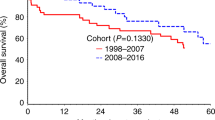Abstract
Purpose
Calcineurin inhibitor use after allogeneic hematopoietic cell transplantation (allo-HCT) is associated with significant magnesium wasting. Utilization of a prolonged magnesium infusion is thought to lead to a lower serum peak concentration and therefore, decreased renal wasting of magnesium. In November 2017, our institution implemented a modification to our inpatient electrolyte replacement protocol for allo-HCT recipients that extended the magnesium infusion rate from 4 g/2 h to 4 g/4 h based on this theoretical advantage. The primary objective of this study was to compare the median magnesium requirements per day of admission between patients who received magnesium 4 g/2 h to patients who received magnesium 4 g/4 h. Secondary objectives included a comparison of the per-patient median serum magnesium concentration during admission, as well as the median incremental difference in serum magnesium concentration after intravenous replacement per patient per admission.
Methods
Allo-HCT recipients who received prolonged infusion magnesium infusions were compared to a historical cohort of allo-HCT patients who received shorter IV magnesium infusions. Admissions were included if the patient had received an allo-HCT within 100 days prior, was admitted to the Transplant and Cellular Therapy Unit at WVU Medicine J.W. Ruby Memorial Hospital, and received at least one magnesium infusion and one dose of cyclosporine or tacrolimus. Admissions were excluded if the patient received oral magnesium, total parenteral nutrition, aminoglycosides, amphotericin, carboplatin, cisplatin, or foscarnet.
Results
The pre-implementation group consisted of 81 admissions (n = 64 patients), while the post-implementation group consisted of 90 admissions (n = 60 patients). Median magnesium requirements per day of admission were not different between groups at 1.4 g of magnesium in the pre-implementation group and 1.9 g of magnesium in the post-implementation group (P = 0.25). Median serum magnesium concentrations and median incremental difference in serum magnesium concentration after intravenous replacement were also not different between groups: 1.65 mg/dL vs 1.60 mg/dL (P = 0.65) and 0.30 mg/dL vs 0.28 mg/dL (P = 0.67), respectively.
Conclusions
Prolonged infusion of magnesium in allo-HCT recipients receiving CNI therapy does not result in improvement in magnesium retention.


Similar content being viewed by others
Data Availability
All data and materials comply with standards.
References
Penack O, Marchetti M, Ruutu T et al (2020) Prophylaxis and management of graft versus host disease after stem-cell transplantation for hematologic malignancies: updated consensus recommendations of the European Society for Blood and Transplantation. Lancet Haematol 7(2):e157-167. https://doi.org/10.1016/s2352-3026(19)30256-x
Gooptu M, Antin JH (2021) GVHD prophylaxis 2020. Front Immunol 12:605726. https://doi.org/10.3389/fimmu.2021.605726
Hamilton BK (2018) Current approaches to prevent and treat GVHD after allogeneic stem cell transplantation. Hematology Am Soc Hematol Educ Program (2018) 1:28–235. https://doi.org/10.1182/asheducation-2018.1.228
Gratreak BDK, Swanson EA, Lazelle RA et al (2020) Tacrolimus-induced hypomagnesemia and hypercalciuria requires FKBP12 suggesting a role for calcineurin. Physiol Rep. 8(1):e14316. https://doi.org/10.14814/phy2.14316
Swaminathan R (2003) Magnesium metabolism and its disorders. Clin Biochem Rev 24(2):47–66
Guerrera MP, Volpe SL, Mao JJ (2009) Therapeutic uses of magnesium. Am Fam Phys 80(2):157–162
Rylander R (2014) Bioavailability of magnesium salts — a review. J Pharm Nutr Sci 4(1):57–59. https://doi.org/10.6000/1927-5951.2014.04.01.8
Ayuk J, Gittoes NJL (2014) Treatment of hypomagnesemia. Am J Kidney Dis 63(4):691–695. https://doi.org/10.1053/j.ajkd.2013.07.025
Snyder M, Shillingburg A, Newton M et al (2016) Impact of intravenous magnesium infusion rate during ambulatory replacements on serum magnesium concentrations after allogeneic stem cell transplant. Support Care Cancer 24(10):4237–4240. https://doi.org/10.1007/s00520-016-3252-9
Ku PM, Waller J, Sportes C, Clemmons A (2018) Prolonged versus short infusion rates of intravenous magnesium sulfate administration in hematopoietic cell transplant patients. Support Care Cancer 26:2809–2814. https://doi.org/10.1007/s00520-018-4127-z
Testani JM, Brisco MA, Turner JM et al (2014) Loop diuretic efficiency. Circ Heart Fail 7(2):261–270. https://doi.org/10.1161/CIRCHEARTFAILURE.113.000895
Author information
Authors and Affiliations
Contributions
All authors have made substantial contributions to the conception/design of the project, data analysis and interpretation, and manuscript draft and review.
Corresponding author
Ethics declarations
Ethics approval
This retrospective chart review study involving human participants was in accordance with the ethical standards of the institutional and national research committee and with the 1964 Helsinki Declaration and its later amendments or comparable ethical standards. This study was approved by the Investigational Review Board at WVU Hospitals.
Consent to participate
Not applicable — research was retrospective in nature.
Consent for publication
All authors grant final approval of the manuscript draft for publication.
Competing interests
The authors declare no competing interests.
Additional information
Publisher's Note
Springer Nature remains neutral with regard to jurisdictional claims in published maps and institutional affiliations.
Rights and permissions
Springer Nature or its licensor (e.g. a society or other partner) holds exclusive rights to this article under a publishing agreement with the author(s) or other rightsholder(s); author self-archiving of the accepted manuscript version of this article is solely governed by the terms of such publishing agreement and applicable law.
About this article
Cite this article
Seago, K., Goodner, J.A., Dillaman, M. et al. Evaluation of prolonged magnesium infusion after allogeneic hematopoietic cell transplant. Support Care Cancer 32, 49 (2024). https://doi.org/10.1007/s00520-023-08257-6
Received:
Accepted:
Published:
DOI: https://doi.org/10.1007/s00520-023-08257-6




